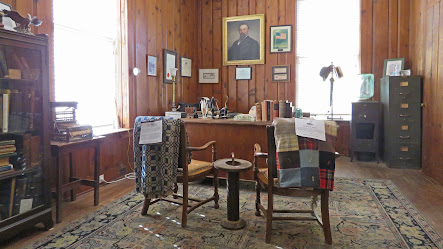After the Civil War, as the south struggled to rebuild it's economy, James H. and William E. Holt, following their father's lead, built their first cotton mill along the Haw River in North Carolina. The location was relatively isolated so company housing was necessarily to attract workers. 48 houses, a company store, a church and a schoolhouse were built. The Glenco Mill complex included the mill, warehouses, dye house, powerhouse, offices, and utility buildings. It was a self contained community and operated like many company towns with low pay and tabs at the company store but the Holts were more generous than most owners. The houses, although drafty, were well built and roomy, rent was cheap, and mill supplied electric power to the houses. Young children were required to attend school rather than work in the mill.

Glenco Mill, which began operations in 1882 manufacturing high quality plaid flannel, was one of the last water powered mills in North Carolina. When it closed in 1954, many of the residents moved away but the village was never a true ghost town. The village, still isolated from the main traffic routes, was in remarkable condition when Preservation North Carolina purchased the property in 1997. The houses were put on the market after the streets were paved and new water, sewer, electric and gas
connections were installed. New owners have to follow a set of design guidelines to ensure that any new construction or future renovation preserves the historic character of the village.


The village consists of 39 restored original houses, 7 historically accurate new houses, the company store and offices, and the mill buildings. Most of the buildings are privately owned and not opened to the public but the company store and the offices house the Textile Heritage Museum. One of the houses is furnished with period pieces and opened to tour.
The basement is the only accessible part of the museum. The accessible entrance is on the left side of the building and the door tends to stick so push hard. The ground floor of the museum has steps to the porch and steps at the entrance doors. The house has steps to the yard and to the porch.
Parking is limited. There's a long accessible spot on the left side of the museum, close to the accessible entrance. Museum 36.13889, -79.42798














This looks wonderful. Lots of history, and those homes really are beautiful. Doubt we'll ever get there, so thanks for sharing your post.
ReplyDeleteYou're welcome! This is a part of the country where we haven't spent much time so were enjoying exploring it.
Delete